What You See in Your Standard Network Setup Hardware
An Cyberspace continued dwelling/home office network, consists of a multifariousness of hardware and software components.
In this tutorial we await at the diverse components that you demand to create a estimator network and connect it to the Internet.
At the end of the tutorial y'all should understand what devices are required to create a domicile network and what functions they serve.
Y'all should as well understand the Internet services that are essential for connecting to and using a dwelling house network and the Internet.
Cyberspace Connection Components and Functions
The diagram below shows a typical dwelling or pocket-size role network layout.
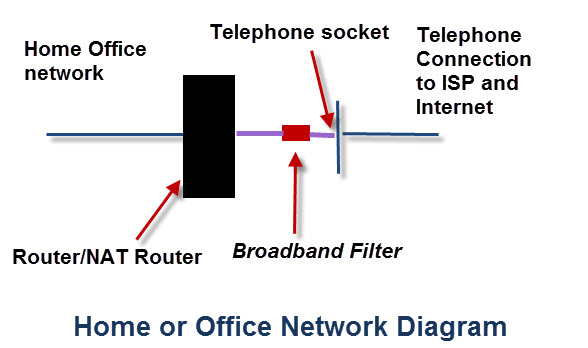
DSL Modem–
This converts digital signals into analogue signals that are suitable for sending over a telephone line. Information technology is commonly congenital into the Internet/broadband router and non normally purchased as a divide component.
DSL/Broadband Filter
Used to filter out DSL signals from telephone signals so that you lot can access the internet and apply the telephone simultaneously.
Firewall and NAT Router
A firewall functions similar a router except that it blocks traffic from the external network according to user configured rules.
A firewall protects your home/small business network computers and devices from intruders on the Net.
Information technology effectively acts like a one fashion digital gate blocking access to your network from devices on the Cyberspace, but at the same time allowing devices on your network to connect to devices on the Internet. (schematic below)
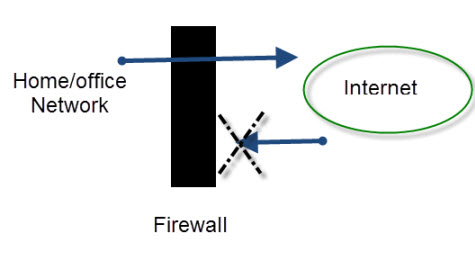
Small networks use a firewall/NAT router combination in which a single device acts every bit a NAT router and firewall.
NAT effectively isolates your abode network from the Internet.
Come across Port forwarding and Internal and external IP Addresses.
Computer Firewalls –
If yous are using Windows XP (or above) then y'all also volition have firewall on your calculator.
This firewall is less secure than the one built into your router/hub just information technology is normal to leave it enabled on your computers.
When you lot install applications e.g. Skype you will find that they alter the firewall settings.
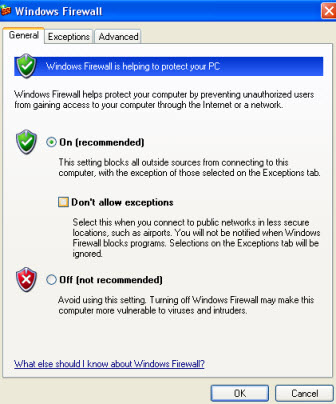
Here is a short video explaining how the computer firewall works.
ICS (Cyberspace Connexion Sharing)-
Internet connection sharing allows you lot to share an Net connection with other computers on a Local/abode Network.
It requires that ane computer be designated as the sharing computer (the reckoner with the Net connection).
This computer functions effectively as a NAT Router, and must be left switched on for the other computers to admission the Internet.
This configuration is not normally used anymore.
Full general Networking Physical Components and Functions
Hubs,bridges and switches are all devices used to connect computers and other devices together on an Ethernet network.

Network Hub
A hub connects two or more computers together (like switch in diagram above).
Hubs are effectively multi port repeaters and operate at the physical layer (level one). They practice non examine the network traffic. They are existence replaced today by the switches. Smallest is usually 4 port.
Network Bridge
A span connects two network segments together and is a selective repeater. It examines the MAC address of the traffic it sees and learns which network segments incorporate the various MAC address.
It uses this information to decide whether or not to repeat the traffic on a network segment.
A Span works at level 2 (information link Level) and will transmit broadcasts.
Bridges are also existence replaced by switches
Network Switch
A switch Connects two or more computers together and used today in preference to a hub or bridge.
Like a bridge a switch learns about MAC address connected to each port and volition only send data on that port that is addressed to those MAC addresses.
A switch is effectively a bridge with more ports.
Using switches normally speeds up a network simply it depends on the network configuration. See the Bones networking Class
In that location are various types being sold marketed equally unmanaged,managed and smart.
A basic unmanaged switch requires zippo configuration. You simply insert it into the network.
A managed switch gives you full control of the switch and usually out of the box behaves like an unmanaged switch. Y'all can withal control the switch,configure the Ports etc. These types are not normally used on abode networks due to the complexity and there being little need.
A smart switch is somewhere in betwixt a managed and unmanaged and is institute on home networks requiring VLANs.
POE Switch
Many modern switches provide POE ports. This allows you to power devices. like cameras. directly from the switch without the demand of an external power supply on the camera. Run into POE explained for beginners
Wireless Access Point
A wireless access point connects wireless devices to an Ethernet network, and to each other.It finer does the same job as a hub/switch only for wireless devices.
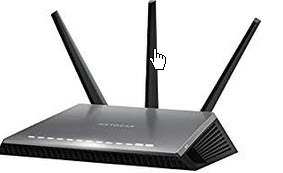
Many Access points can be powered using POE (Power over Ethernet) which ways that they tin be placed in positions where there is no mains connection making them very flexible. See POE explained for beginners
PoE Injector
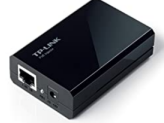 These are used to connect a PoE finish device to a not PoE device like a legacy switch. The legacy switch cannot provide the power so the injector does.
These are used to connect a PoE finish device to a not PoE device like a legacy switch. The legacy switch cannot provide the power so the injector does.
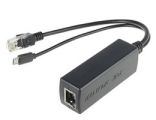 PoE Splitter – This Splits the data from the ability and is used to connect a non PoE finish device to PoE source.
PoE Splitter – This Splits the data from the ability and is used to connect a non PoE finish device to PoE source.
The power extracted by the splitter is oft used to power the device using a split ability input.
The ane shown is the DSLRKIT Active PoE Splitter used to power the Raspberry Pi.
Home Routers
A router connects networks together. Routers operate at the networking level of the TCP/IP protocol stack.
On Home networks the router is responsible for connecting the home network to the Internet and provides several of import networking services like:
- DHCP
- DNS
Virtually abode routers provide both Wi-Fi and Ethernet connections.
Home routers too provide NAT (Network Address translation) services.
They are also commonly known as hubs but this doesn't actually draw their networking role.
Abode Router Net Connection Types
A router connects 2 networks together.
In the instance of an home router the networks are the Internet and the home network as shown in the diagram below.

There are 4 main Internet connection types in use
- ADSL – old
- VDSL – Used with Fibre to cabinet connections (FTTC)
- Fibre – Used with FTTP
- Cable – Cablevision networks
If yous buy your own router so you need to ensure it is the correct blazon for your Internet connection.
Routers and Modems and Filters
If you wait at the internet connection diagram higher up you will see a broadband filter.
This filter is necessary on ADSL and VDSL connections, but is now unremarkably included in the ISP socket.
Withal you will need to cheque your socket type to make up one's mind this.
What isn't shown is a modem.
A modem, if required, is placed betwixt the router and the internet connection.
External modems are unremarkably institute on Networks that connect using fibre, and are required to convert electric signals from the router into lite signals to send over the fibre cable.
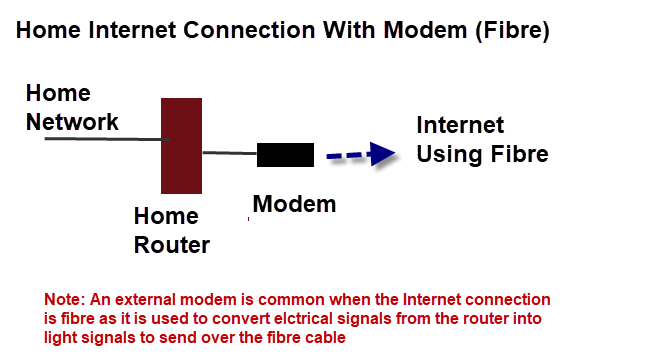
VDSL and ADSL
Internet connections that use telephone cables to connect to the Internet use these link protocols or technologies.
ADSL (Analogue digital subscriber line) is the older technology, and is at present being replaced by VDSL (very loftier speed digital subscriber line) which is faster.
VDSL isn't fibre, but it is used in conjunction with fibre in what is know as fibre to the kerb connections.
In these connections the fibre is provided to a distribution point virtually the home, and the standard telephone lines provide the connectedness to the home using VDSL.
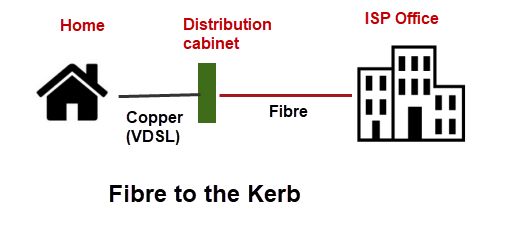
Dwelling Routers Without a Land Line
Traditionally Internet connections have required a land line connection.
Nevertheless more than and more people are not using a traditional state line telephone connectedness, but a mobile phone.
There are many home routers on the market place that support 3G and 4G mobile networks.
They were originally designed for use past mobile workers or people on holiday that required to share a mobile Internet connexion.
Usually they provide a Wi-Fi access point and Ethernet connections but similar a traditional home router but the connection to the ISP is via the mobile network as shown below.
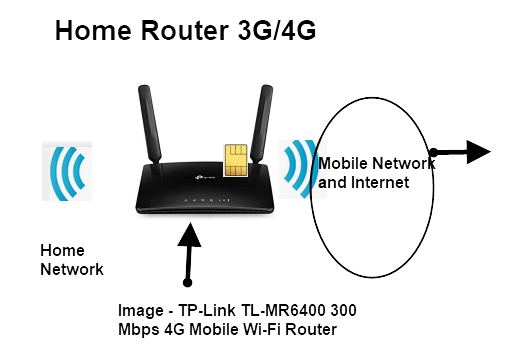
Before you lot purchase one for home apply yous should check the network availability in your expanse.
The upload and download speeds are mostly slower than land line with 3G giving between 200kbps and 7.2Mbps.
4G giving viii-10 Mbits/s (quoted speeds) in the UK but published speeds are much college with 4G having maximum download speed of around 160Mbits/due south.
Hither is a screen shot from the ee mobile provider.

Dual Routers (VDSL/ADSL/Fibre) + Mobile
Many routers now provide two Internet access methods for redundancy purposes and are increasing popular with the current work at dwelling trend.
The main connection is commonly VDSL/ADSL or fibre but when this fails it volition autumn dorsum to the mobile connectedness automatically.
Providing two net connection methods on a home is too possible using a standard home router and standalone 3G/4G router just in this case you lot would need to make changes to you customer to use the 3G/4G connectedness as it wouldn't exist automatic.
Wi-Fi Range Extender/Repeater
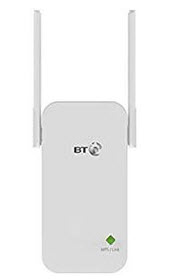 Place in range of the existing Wireless network, and it volition take the signal from the network and rebroadcast it, thus increasing the range of the network.
Place in range of the existing Wireless network, and it volition take the signal from the network and rebroadcast it, thus increasing the range of the network.
Modern ones plug directly into a mains socket and require no other connections.
Note: see Wi-Fi homeplug adapters beneath.
Mi-Fi -BroadBand Wi-FI Hub
A Mi-Fi Hub is a relatively new device, and it can be used for connecting multiple devices to the Net over the mobile network (3g and 4G).
Your devices connect to the hub using Wi-Fi and the Hub connects to the mobile network using 3G/4G .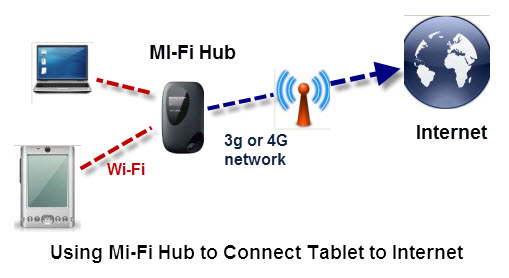
Mi-Fi hubs are low cost ( around £20 to £40) and many volition work hours without being connected to the mains.
You will demand a Sim and a mobile data plan.
Homeplug Adaptor
These are Ethernet cards that plug direct into a mains socket, and employ the mains wiring to carry the Ethernet signal instead of using UTP cable.
They come in pairs and yous need a minimum of two adapters.
They plug into the mains and have an Ethernet socket that y'all tin can use to connect to a calculator,switch , router etc.
You tin can also get ones that function as Wireless Access points which are used for extending a networks to overcome range limitations of Wi-Fi.
These look like a normal homeplug adapters just take a wireless access point built in.
See Homeplug adaptors and Powerline networking and extending a home network.
Wi-Fi Range Extender/Repeater vs Wi-Fi Homeplug
A Wi-Fi range extender needs to be in range of an existing Wi-Fi network to piece of work.
A Wi-Fi homeplug adaptor needs to be continued to some other homeplug adapter using the electrical mains.
Wi-Fi homeplug adaptors give yous much better performance than range extenders.
UTP (Unshielded Twisted Pair) Cables
Common cable for connecting Ethernet devices together.Ranges from CAT5 to CAT6.
Older Installations volition use CAT5 and newer ones CAT6, which is designed for higher speeds.
Hither is a skillful video roofing the differences between UTP and STP, straight vs crossover, and the different categories.
Wiki On cat6 cable and true cat 5.
Come across How to Wire your Home Network
Ethernet Crossover Cable
Used to connect two computers together without requiring a hub/switch.
Information technology is also used for connecting older hubs/switches in cascade. Not normally required today as the newer hubs/switches utilise auto observe and can switch modes.
Run into Wiki on Ethernet crossover cable and Medium dependent interface
Cable Coupler/Extender and Splitter
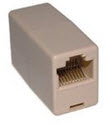 Low price and very useful for joining Ethernet cables together.
Low price and very useful for joining Ethernet cables together.
Simply Plug an Ethernet cable into each socket.
Y'all can also utilize an Ethernet splitter to extend a cable, and provide more Ethernet sockets,
Connector are RJ45
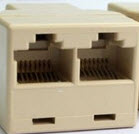
Useful Resources:
How to wire your own domicile network PCworld tutorial and This video .
Networking and Internet Services
Just having computers connected together by WI-FI or Ethernet is the showtime step. To exchange information they require to have, and use several networking services and protocols.
The primary ones are:
IP protocol
All modern networks use the IP networking protocol, and to piece of work on a network all devices crave an IP address.
There are 2 versions of the IP protocol currently in performance.
IPv4 is the original version and is deployed in all habitation and office networks and on the Internet.
IPv6 is being rolled out and many new networks and network devices back up it, just it isn't used as the default protocol.
DHCP (Dynamic Host configuration Protocol)
DHCP is a service and protocol that requests and assigns IP addresses to computers automatically.
All modernistic computers,tablets and smart phones are capable of using DHCP and are configured to use it past default.
For habitation and small function networks the DHCP service is built into the router that connects to the Internet.
For larger part networks this service is configured on a network server.
If no DHCP service is available clients will automatically assign their own IP address (known equally a local address) or you can manually assign them( called static addresses).
Come across understanding DHCP on Habitation Networks
DNS (domain Name Service)
The domain name system is the eye of the Internet. Information technology is responsible for resolving domain names to IP addresses.
Without DNS you would have to recollect the IP address of each website that you visited.
All networking clients (PCs,tablets,Phones) function every bit DNS clients and take the necessary software built in so that they tin use DNS.
The DNS servers shop the data and are mainly located on the Internet due east.g. your ISP (internet service provider,Google etc).
Large companies volition apply their ain DNS servers locally.
To use DNS the client will need to know the accost of a DNS server. This is normally assigned by the DHCP server.
See Understanding DNS
Search Engines
DNS is crucial to the Internet and search engines are crucial for the Web.
For most people the procedure goes similar this
- Utilize search engine search e.thousand.Google
- Click on desired link.
- Web browser uses DNS to locate the IP address of the website. (not visible to user)
- Browser displays content from website.
Common Networking Terms and Acronyms
MAC Address – The 64 bit Concrete address of the device which is assigned to the Wi_fi adapter or NIC. Cannot normally exist changed.
NIC– Network Interface card. Ethernet card found in computers
UTP- (Unshielded twisted pair)- Common cable for connecting network devices.
RJ45- Connector used for connecting Ethernet devices.
RJ11- Connector used for connecting telephones,modems etc in U.s. and adopted in other countries.
Gateway – A gateway works at the application level of the TCP/IP protocol stack and does a translation. Examples are electronic mail to FAX gateways.
On before networks and in earlier networking courses routers were called gateways, and the term is notwithstanding used when setting up networking clients.
In this context the term gateway refers to the gateway to an external network i.e. the Internet.
Uni-bandage Message – Message sent from i device to another.
Multicast Message -Message sent from one device to several others.
Circulate Message -Message sent to all nodes on the network.
Quick Quiz
Q1 – Which device is not required to connect to the Internet connection?
- Router
- Modem
- Switch
Q2-Which of the following components is non required for a home network?
- Router
- Switch
- Wireless Access point
- Ethernet crossover Cable
Q3 -What hardware is essential to creating a home wi-fi network?
- Router
- Switch
- Wireless Access signal
- Ethernet crossover Cable
Q4 -A gateway is a common network hardware component that does what?
- Connects several computers together.
- Resolves names to IP addresses
- Assigns IP addresses
- Connects a network to the Internet.
Related Articles
- The TCP/IP protocol suite explained
- Wi-Fi and Wireless Networking
- How Networks work beginners grade
- Building a Home Network
- Home Network Troubleshooting
Answers
Q1-A switch.
Q2- Ethernet crossover Cable
Q3 -Wireless Admission point
Q4- Connects a network to the Internet.
Please Let me Know if you found it Useful
0 Response to "What You See in Your Standard Network Setup Hardware"
Post a Comment